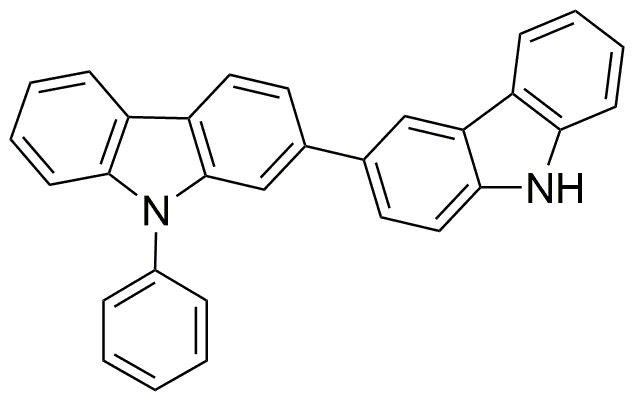9-Phenyl-9H,9'H-2,3'-bicarbazole is widely utilized in research focused on:
- Organic Electronics: This compound is used in the development of organic light-emitting diodes (OLEDs), enhancing the efficiency and color purity of displays in smartphones and televisions.
- Photovoltaic Cells: It plays a crucial role in organic solar cells, where it helps improve light absorption and conversion efficiency, making renewable energy sources more viable.
- Fluorescent Sensors: The chemical is employed in creating fluorescent sensors for detecting environmental pollutants, providing a sensitive and effective method for monitoring air and water quality.
- Biomedical Applications: It is investigated for use in drug delivery systems, where its properties can enhance the solubility and bioavailability of therapeutic compounds.
- Research in Material Science: This compound is studied for its potential in developing new materials with unique electronic and optical properties, paving the way for innovative applications in various technologies.
General Information
Properties
Safety and Regulations
Applications
9-Phenyl-9H,9'H-2,3'-bicarbazole is widely utilized in research focused on:
- Organic Electronics: This compound is used in the development of organic light-emitting diodes (OLEDs), enhancing the efficiency and color purity of displays in smartphones and televisions.
- Photovoltaic Cells: It plays a crucial role in organic solar cells, where it helps improve light absorption and conversion efficiency, making renewable energy sources more viable.
- Fluorescent Sensors: The chemical is employed in creating fluorescent sensors for detecting environmental pollutants, providing a sensitive and effective method for monitoring air and water quality.
- Biomedical Applications: It is investigated for use in drug delivery systems, where its properties can enhance the solubility and bioavailability of therapeutic compounds.
- Research in Material Science: This compound is studied for its potential in developing new materials with unique electronic and optical properties, paving the way for innovative applications in various technologies.
Documents
Safety Data Sheets (SDS)
The SDS provides comprehensive safety information on handling, storage, and disposal of the product.
Product Specification (PS)
The PS provides a comprehensive breakdown of the product’s properties, including chemical composition, physical state, purity, and storage requirements. It also details acceptable quality ranges and the product's intended applications.
Certificates of Analysis (COA)
Search for Certificates of Analysis (COA) by entering the products Lot Number. Lot and Batch Numbers can be found on a product’s label following the words ‘Lot’ or ‘Batch’.
*Catalog Number
*Lot Number
Certificates Of Origin (COO)
This COO confirms the country where the product was manufactured, and also details the materials and components used in it and whether it is derived from natural, synthetic, or other specific sources. This certificate may be required for customs, trade, and regulatory compliance.
*Catalog Number
*Lot Number
Safety Data Sheets (SDS)
The SDS provides comprehensive safety information on handling, storage, and disposal of the product.
DownloadProduct Specification (PS)
The PS provides a comprehensive breakdown of the product’s properties, including chemical composition, physical state, purity, and storage requirements. It also details acceptable quality ranges and the product's intended applications.
DownloadCertificates of Analysis (COA)
Search for Certificates of Analysis (COA) by entering the products Lot Number. Lot and Batch Numbers can be found on a product’s label following the words ‘Lot’ or ‘Batch’.
*Catalog Number
*Lot Number
Certificates Of Origin (COO)
This COO confirms the country where the product was manufactured, and also details the materials and components used in it and whether it is derived from natural, synthetic, or other specific sources. This certificate may be required for customs, trade, and regulatory compliance.


